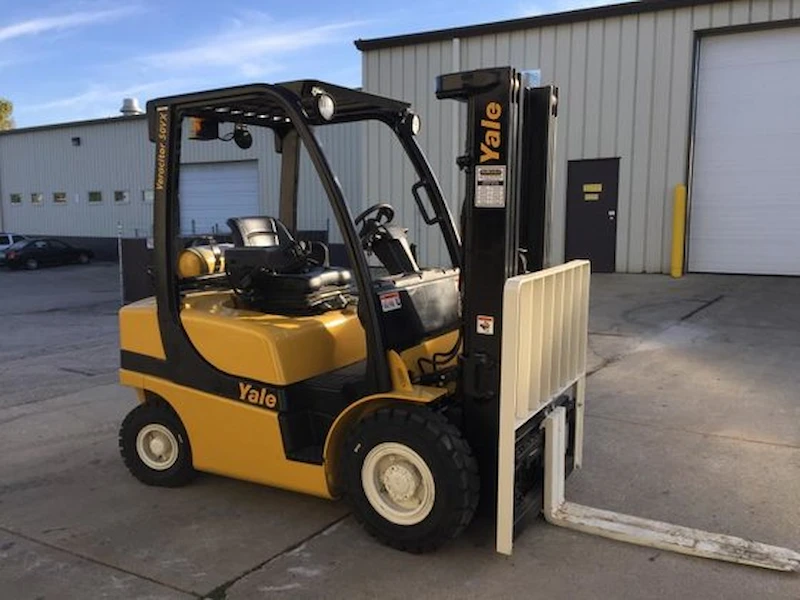The Yale GLP050VX is a robust and highly efficient forklift model, designed to handle diverse industrial needs with ease and reliability. A vital part of the Yale GLP050VX forklift’s functionality is its TOSS (Tilt and Offset Sensor System). This system plays a critical role in ensuring the stability and smooth operation of the forklift by monitoring its mast’s tilt and shift angles. Understanding how the TOSS sensor works, its location, and how to maintain it properly is essential for maximizing the performance and longevity of the forklift.
What is the TOSS Sensor?
The TOSS sensor is a highly specialized device integrated into forklifts to monitor the tilt and offset of the forklift mast. It measures how far the mast tilts forward or backward, providing essential data for maintaining a stable load. The sensor is linked with the hydraulic system of the forklift, ensuring that the operator receives accurate and real-time feedback on the positioning of the mast.
The tilt and offset data gathered by the TOSS sensor allows for better control of the load, reducing the risk of tipping and improving operational efficiency. Additionally, the TOSS sensor helps the forklift’s control unit make real-time adjustments to the mast’s angle, keeping the load secure during lifting, lowering, and horizontal movements.
TOSS Sensor Location in the Yale GLP050VX
On the Yale GLP050VX model, the TOSS sensor is strategically placed within the mast assembly, typically at the lower end of the mast. This location ensures that the sensor can effectively monitor the tilt angle and provide accurate data to the forklift’s control system. In this position, the TOSS sensor is well-protected from external elements while maintaining direct connectivity to the hydraulic system for precise data collection.
The placement of the TOSS sensor is crucial for its performance. If installed incorrectly or if it’s exposed to too much external force, the sensor may malfunction, leading to inaccurate readings or complete system failure. This can significantly affect the performance of the forklift and, more importantly, the safety of the operator and the load being carried.
Maintenance of the TOSS Sensor
Regular maintenance of the TOSS sensor is essential to ensure that it functions optimally throughout the lifespan of the forklift. The maintenance routine for the TOSS sensor generally involves the following steps:
-
Inspection: Periodic visual inspections should be conducted to check for any visible damage to the sensor or its wiring. Ensure that the sensor is properly connected to the hydraulic system and there are no loose or disconnected wires. Any physical damage to the sensor itself may result in malfunction and should be addressed immediately.
-
Cleaning: Over time, dust, dirt, and grease can accumulate on the sensor and its components, potentially affecting its performance. Cleaning the sensor regularly helps prevent buildup that can obstruct the sensor’s ability to function accurately. Use a soft cloth or brush to gently remove debris from the sensor and its connectors.
-
Calibration: Calibration ensures that the TOSS sensor is reading accurate tilt and offset data. Over time, the sensor may require recalibration due to wear and tear. Typically, this requires special equipment to ensure that the sensor aligns with the forklift’s hydraulic system and provides precise readings.
-
Wiring and Connectivity Check: As part of routine maintenance, it is crucial to inspect the wiring and electrical connections to ensure that the TOSS sensor is properly connected to the forklift’s control system. Any loose or frayed wiring could result in intermittent data or sensor failure, leading to issues with mast positioning and load stability.
-
Testing for Accuracy: After maintenance, it’s important to test the sensor to ensure that it is working correctly. This involves lifting and lowering the mast and checking for accurate tilt readings. Any discrepancies should be addressed immediately to prevent safety hazards.
Common Issues with the TOSS Sensor
Like any mechanical and electronic component, the TOSS sensor may experience some issues over time. Some of the most common issues include:
-
Incorrect Tilt Data: If the sensor begins to read inaccurately, it could cause the forklift’s mast to tilt incorrectly, leading to unsafe load handling.
-
Sensor Failure: Over time, sensors may fail entirely due to damage or wear. When this happens, the forklift’s control system will no longer receive tilt data, which can make operating the forklift unsafe.
-
Wiring Issues: If the wiring to the sensor becomes loose or damaged, the sensor may stop functioning or provide incorrect data to the system. Regular inspection of the wiring can help identify these problems early.
-
Calibration Issues: A miscalibrated TOSS sensor can lead to inaccurate data readings, which can affect the performance of the forklift. Regular calibration ensures that the sensor continues to provide accurate feedback.
Importance of TOSS Sensor Maintenance
The TOSS sensor is an integral part of the forklift’s safety and efficiency systems. Without it, operators would be unable to monitor or control the mast’s angle accurately, increasing the risk of accidents, particularly in environments where heavy loads are being lifted. Properly maintaining the sensor ensures that the forklift remains stable, reducing the likelihood of accidents and damage to the load.
In addition to safety, regular TOSS sensor maintenance ensures that the forklift operates at peak performance, improving its lifespan and reducing the likelihood of costly repairs or downtime.
Conclusion
The Yale GLP050VX is a dependable forklift designed for heavy-duty operations, and its TOSS sensor plays a crucial role in ensuring safe and efficient material handling. Proper placement, regular maintenance, and timely calibration of the TOSS sensor are vital to the forklift’s continued performance and the safety of the operators. By understanding its role, location, and maintenance requirements, operators can keep their forklifts running smoothly and avoid costly downtime or safety issues.
If you are experiencing any issues with the TOSS sensor or have concerns about the functionality of your Yale GLP050VX forklift, consult a professional technician who can diagnose and repair the problem, ensuring the forklift continues to operate at its best.
Visit the rest of the site In Tech Times for more interesting and useful articles. Thank you!




